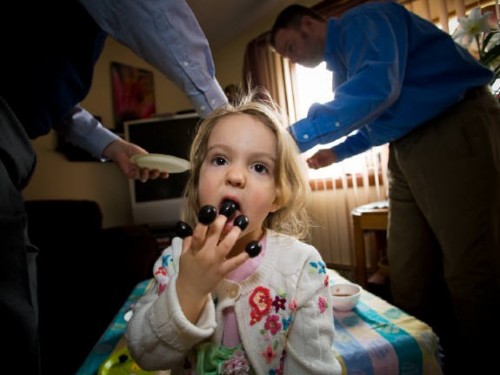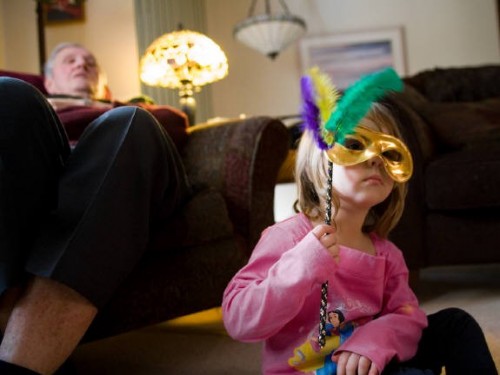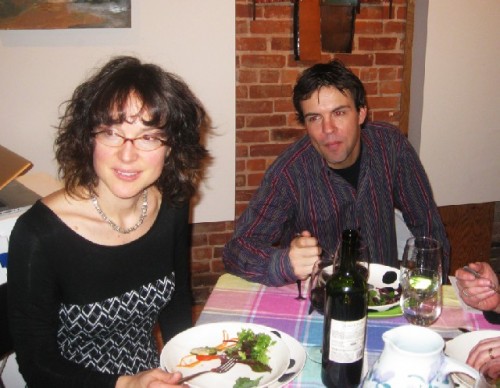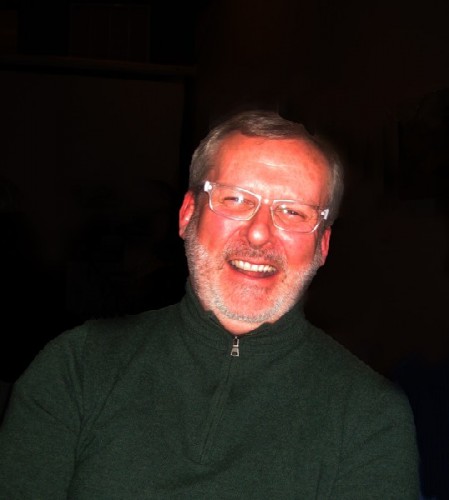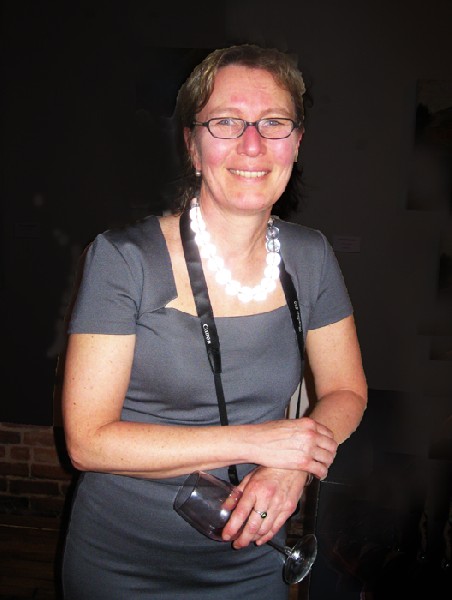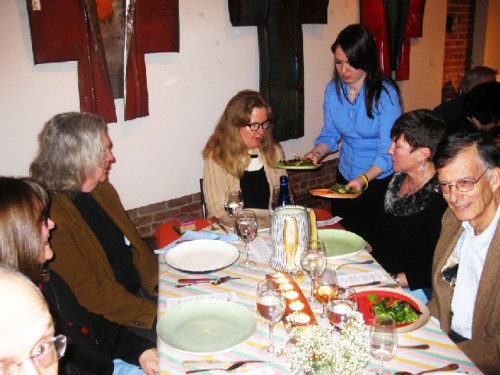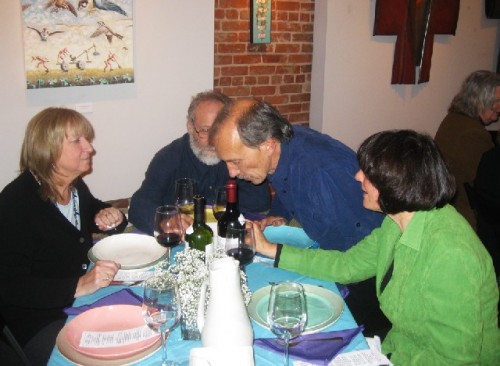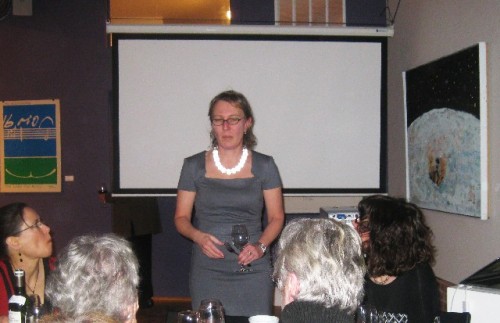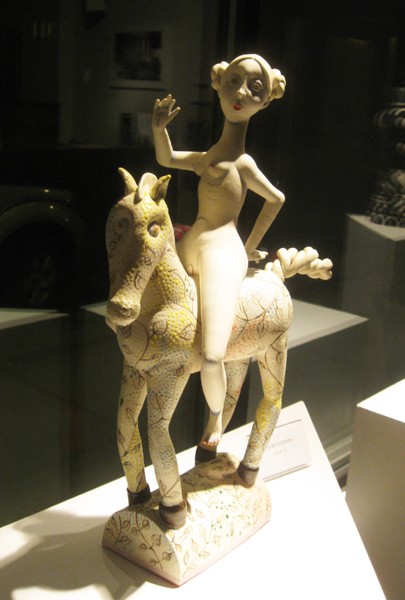Ferrin Gallery: Dish & Dine
Family of Mine by Jason Houston
By: Charles Giuliano - Feb 21, 2010
Since moving from Lenox, to a larger space in Pittsfield, Leslie Ferrin has also expanded the scope of her gallery. She is an authority on studio pottery and ceramic art. In the past few years she has delved deeply into all aspects of Berkshire artists and now shows painting, sculpture, and photography. On many levels she is considered to have a keen eye which has resulted in the most ambitious and prestigious gallery in the Berkshires.
Ferrin is also deeply embedded in the cultural renaissance of Pittsfield. Maggie Mailer, a star of her stable of artists, once worked for the gallery while launching the Storefront Artists Project. The gallery has hosted a number of events and benefits including inventive dinners combining pottery and food such as "Locally Grown, Locally Thrown."
Last night, the gallery hosted a sit down dinner for 40 which launched the series Dish & Dine. The theme was to present the work of gallery artists including an exhibition by the photographer, Jason Houston, in a twist on the famous 1955 MoMA show, curated by Edward Steichen, Family of Man. His show is titled Family of Mine. The porcelain plates we dined on were created by Mary Anne Davis. Ferrin's family helped with her mom in the kitchen organizing the food catered by The Market and served by her teenage daughter. In return for an evening of work Mom paid her monthly cell phone bill. All that texting you know. Other gallery artists like the German ceramic sculptor, Gerit Grimm, helped with the evening.
It was an upbeat and ambitious event but Ferrin displayed some opening night jitters. When we called for reservations ($35 each and BYOB) there were only 15 signed up. There was a last minute rush, perhaps folks were keeping an eye on the weather, and she ended up turning people away. As the evening evolved she addressed us from time to time with some trepidation. There was no coffee or tea during the desert. "I just forgot. We'll do that next time" she said.
Graciously, Ferrin credited all those who participated. The food was catered by the recently opened The Market a neighbor at 391 North Street. The menu included mixed greens with balsamic vinaigrette from Equinox Farms. There was a seasonal root vegetable puree (awesome). From Woodstock Farms, a mustard rubbed, roast pork loin. There was a 'goody bag' as we left, a half dozen organic eggs, from Crazy Wife Farms in Alford, Mass. We served them scrambled with shitake mushrooms this morning.
Between courses Ferrin introduced the photographer Houston. He gave a fascinating power point talk showing the diversity of global projects. The assignments have taken him to South Africa, Borneo, Nicaragua, Mexico and other exotic destinations. He took questions from the audience which led to a lively discourse. His images regularly appear in Berkshire Living Magazine. He is also photo editor of Orion Magazine which has its office in Great Barrington. The images from Third World destinations were stunning as well as evocative in their social implications.
Houston discussed the work within the concept of the Concerned Photographer. He tracked that to the collaboration of Walker Evans and James Agee. The assignment for Fortune Magazine to document farmers during the Great Depression took several years and was ultimately rejected. Their work was published as the book Let Us Now Praise Famous Men. The first edition was small and did not sell well. It has gone through reprinting and has become one of the most influential publications of its kind.
Instead of "illustrating" the text of Agee in the book the images by Evans were presented as a portfolio section. The book essentially combined two separate but equal projects between a photographer and a writer. It is a format that has become the norm for photography publications. Evans returned to visit the families years after the project was completed. He was seminal in breaking down the wall between a journalist and his subject. There is nothing objective about his images. They are meant to evoke empathy for the squalor depicted which was presented with respect and dignity. For young photographers like Houston they are big shoes to step into.
During the lively Q&A Houston was asked to define the difference between journalism and documentary photography. In general, it has to do with the length of time spent on a subject. A photo journalist shoots quickly and attempts to capture the editorial essence of the event. Usually a photographer accompanies a reporter.
A documentary photographer may also work with a writer and Houston gave several example of these collaborations. It is the norm to spend more time, months, and even years working on location. You live and eat with the people you are photographing. This can entail out back conditions, funky food, and high risk urban environments. He described a hundred mile per hour cab ride in South Africa running red lights. To drive more slowly entailed risk of being carjacked and mugged. At times he paused to reassure his wife who looked at him furtively.
The South African series combined black and white as well as color photography. He explained that it was the last time he used film; some 300 rolls. And that he always wore two cameras loaded with both black and white and color. "A lot of times I shot scenes using both black and white and color. Now that I shoot digitally I can make that editorial decision later." All that film and processing was expensive. But the switch to digital entailed investment and maintenance of costly equipment. Overall, anyone who has switched to digital, has little urge to return to wet process photography. What took hours in the darkroom can be done in minutes with Photoshop.
Later Houston joined our table to talk with Berkshire Museum director, Stuart Chase, who has shown his work, and John Stomberg, a curator and associate director of the Williams College Museum of Art. Stomberg, who I knew from graduate school at Boston University, wrote his dissertation on photography and Fortune Magazine. He and Houston appeared together on a panel about documentary photography at Storefront Artists.
Ferrin also introduced a number of gallery artists who attended the event. She discussed upcoming projects including a solo show of paintings with a Biblical theme by Paul Graubard (March 13-May 8) and vintage Berkshire cultural posters by John Stritch (March 13 to May 8). She promised another dinner in April.
While clearing dishes from our table Ferrin commented "In a creative economy this is an example of being creative." It was a fabulous evening with terrific schmoozing. We exchanged e mail addresses with Mary Anne Davis and plan to meet again over dinner in Pittsfield. Her husband is a science writer whom I introduced to Chase. They exchanged contact info. Astrid connected with the ceramic artist, Gerit Grimm and is planning a studio visit.
Combining fine dining, wonderful art, and terrific networking I told Ferrin that we had gotten a lot of bang for the buck. For the cost of dinner at a restaurant there was so much more. Sign us up for April. The next evening is sure to be another hit.

